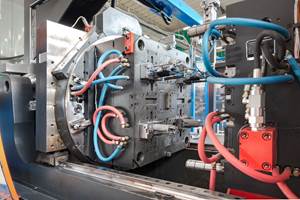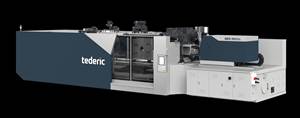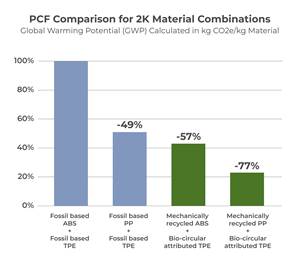Do's and Don'ts for Overmolding Liquid Silicone onto Thermoplastics
Hard/soft overmolding has become a fundamental technique for injection molders in recent years, and a growing number of molders are extending that technology thermoset/thermoplastic combinations.
Hard/soft overmolding has become a fundamental technique for injection molders in recent years, and a growing number of molders are extending that technology thermoset/thermoplastic combinations. In some applications, liquid silicone rubber (LSR) offers advantages over TPEs in its heat resistance, extreme low-temperature flexibility, chemical resistance, and inherent lubricity. While good long-term adhesion can be an issue in overmolding TPEs onto rigid thermoplastic substrates, the challenge is even greater with LSR on thermoplastics.
Preparing the substrate surface with chemical primers or plasma or UV treatment has been one approach to the adhesion challenge. To minimize processing steps, LSR suppliers have come out with newer “primerless” or “self-adhesive” grades that bond well on their own with thermoplastics (see accompanying case history). Even so, there are some rules to observe in order to obtain good results. Here are some key points of advice offered by Eric Bishop, North American marketing manager for Shin-Etsu Silicones of America, Inc. in Akron, Ohio (shinetsusilicones.com). Shin-Etsu supplies Select-Hesive LIMS for primerless adhesion to thermoplastics.
•Keep it clean. “Cleanliness is critical to adhesion, so keep the substrate clean and dry,” says Bishop. That is less of an issue if the substrates are molded in a two-shot mold with the LSR, rather than molded separately and transferred from one machine to another.
•Serve it up hot. “It is vital for substrate parts to be hot,” Bishop states. “The bonding of LSR to the thermoplastic is a chemical reaction. It needs a combination of time, temperature, and pressure. In general, he says, hotter is better. Typical mold temperatures for LSR are 300 to 400 F and the minimum is 250 F. The LSR has to achieve at least that internal temperature to cure adequately. Hotter is also faster—meaning shorter cure cycles.
You also don’t want to overmold LSR onto a cold substrate, which will slow curing, Bishop cautions. In two-shot overmolding that’s not a problem—residual heat in the thermoplastic part will help cure the LSR. But if the substrate is molded separately, it may need preheating in a conveyor oven or with a hot plate.
•Watch out for additives, mold releases. Bishop advises against usin thermoplastic substrates with internal mold releases or “self-lubricating” additives, though they do not always create an adhesion problem. External mold releases are a definite no-no. And avoid any additives containing sulfur or amines, which inhibit cure of LSR. That means amine-based antistats can be a problem.
•Demold gently. Even though LSRs have good “green strength” right out of the mold, when the mold opens, adhesion and curing may not have achieved their final state. So avoid pulling or stretching the LSR during demolding. Bishop notes that a PTFE mold coating can help with release of the LSR.
•Consistency counts. If you follow all the advice above, you should get good results with self-adhesive LSR regardless of whether you use two-shot molding in one machine or separate molding in two machines. But with two machines, it definitely helps to use automated (robotic) transfer from one to the other, Bishop says. That way ensures a consistent substrate temperature for overmolding and also avoids any contamination from a human operator handling parts.
•Mechanical interlock helps. Even with self-bonding LSR, it’s good insurance to incorporate some form of mechanical interlock between the materials into the part design. Allowing LSR to penetrate through-holes onto the back side of the part is a good example. A rough finish on the overmolding interface area can help, but isn’t required with a good self-bonding material.
•Do a preliminary test. To get a good idea of how well your substrate material will bond to a particular LSR grade, it’s a good idea to send a representative part or sample plaque of the substrate material to the LSR supplier for testing.
Related Content
Molder Opts for Machine Flexibility for Complex Jobs
AE Plast opted for tiebarless multimaterial Engel victory machines as it took on complex parts for the appliance and power tool market, including a 3K housing for Dremel’s rotary tool.
Read MoreFakuma 2023: Wittmann Battenfeld Expands All-Electric Line, Direct-Current Capabilities
Wittmann Battenfeld will introduce the new EcoPower B8X injection molding machine line and show direct current as an energy source for a concept machine that will power its own robot.
Read MoreTederic Promotes High Technology, Broader Market Presence
Four cells are running in its booth including a 1,300-ton multimaterial system highlighting its 2K capabilities.
Read MoreMore Sustainable Two-Component Overmolding
Swedish compounders HEXPOL TPE AB and Polykemi AB have collaborated on a 2K sustainable development project for consumer products.
Read MoreRead Next
Recycling Partners Collaborate to Eliminate Production Scrap Waste at NPE2024
A collaboration between show organizer PLASTICS, recycler CPR and size reduction experts WEIMA and Conair will seek to recover and recycle 100% of the parts produced at the show.
Read MorePeople 4.0 – How to Get Buy-In from Your Staff for Industry 4.0 Systems
Implementing a production monitoring system as the foundation of a ‘smart factory’ is about integrating people with new technology as much as it is about integrating machines and computers. Here are tips from a company that has gone through the process.
Read MoreMaking the Circular Economy a Reality
Driven by brand owner demands and new worldwide legislation, the entire supply chain is working toward the shift to circularity, with some evidence the circular economy has already begun.
Read More











 (2).jpg;maxWidth=300;quality=90)














